Key takeaways:
- Creativity in teaching, especially in music education, enhances student engagement, self-expression, and emotional growth.
- Collaboration with other educators and communities, as well as leveraging technology, can maximize limited resources and foster innovative learning experiences.
- Building community support through events and partnerships increases visibility, pride, and support for music programs.
- Adapting teaching methods and utilizing digital tools can maintain student motivation and enhance learning, even amidst resource constraints.
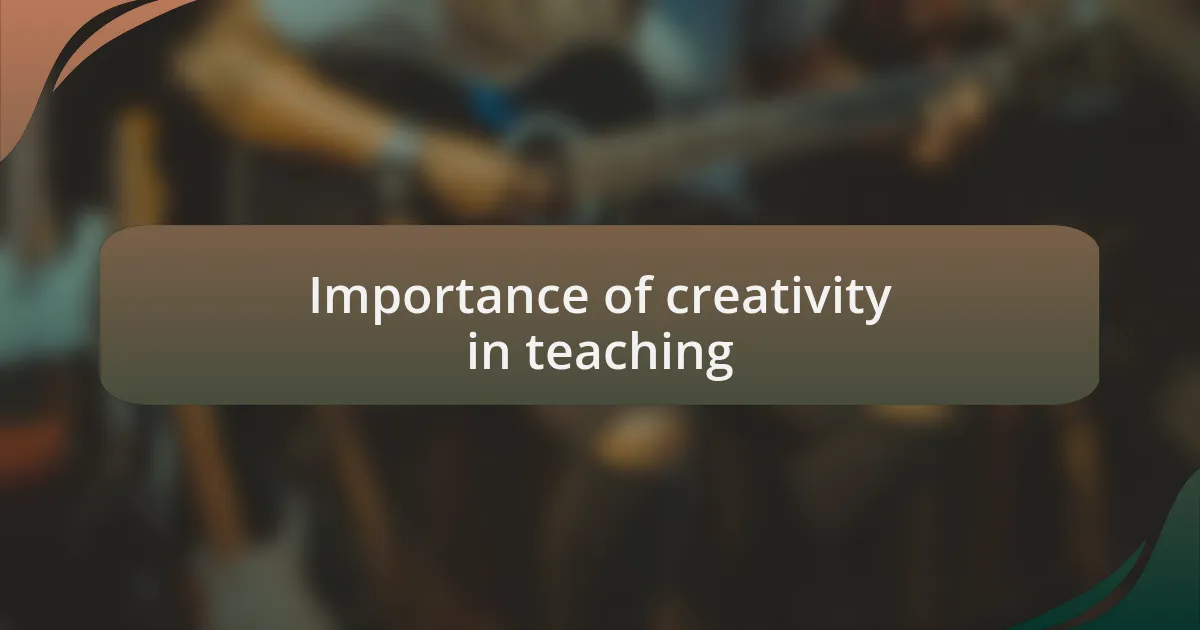
Importance of creativity in teaching
Creativity in teaching is essential, especially in music education, where the subject thrives on expression and innovation. I recall a time when I had limited resources for my class, and rather than letting those constraints stifle the learning experience, I encouraged my students to create their own instruments. It was incredible to see how their imaginations turned everyday items into unique tools for making music.
I often ask myself: How can we expect students to engage with music if we don’t introduce them to the joy of creativity? When I started incorporating improvisational exercises into my lessons, the atmosphere shifted dramatically. Students who were previously shy began to take risks, sharing their ideas, which ultimately fostered a sense of community and collaboration.
Moreover, embracing creativity allows for personal connections to be made in the classroom. I remember helping a student struggling with self-expression, who found solace in writing lyrics. Watching that transformation reaffirmed my belief that creativity not only nurtures musical skills but also supports emotional growth. Wouldn’t we all benefit from a space that values inventiveness?
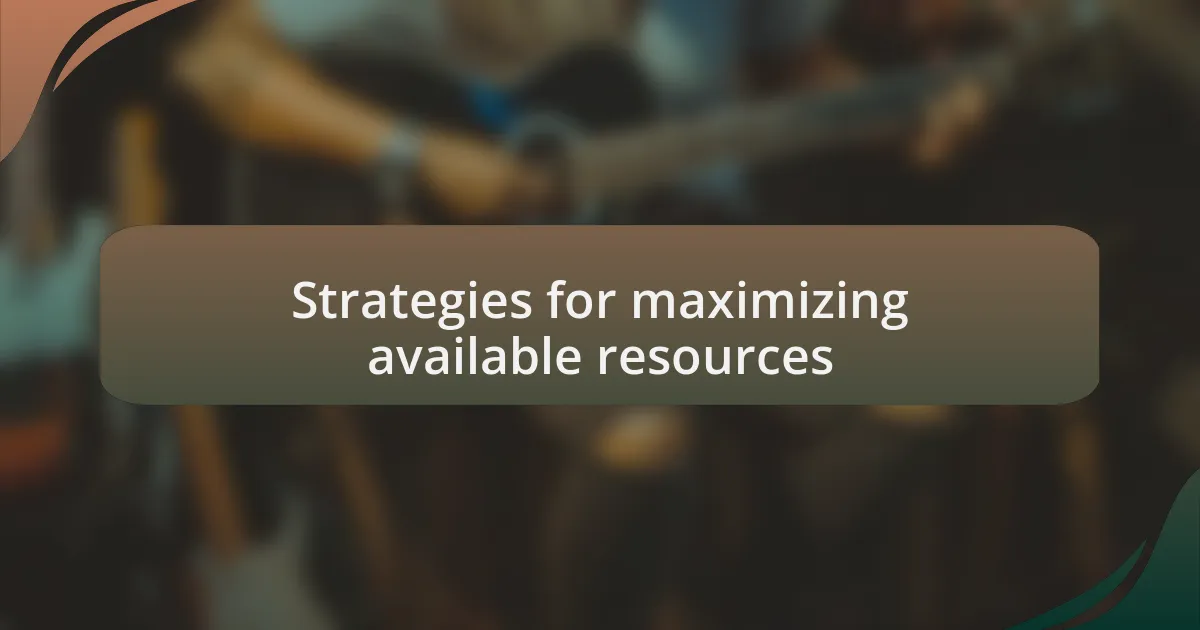
Strategies for maximizing available resources
When faced with resource limitations, collaborating with other educators can be a game-changer. I remember partnering with a visual arts teacher to create a cross-disciplinary project where students used visuals to express musical themes. It was fascinating to witness how different mediums can inspire creativity and deepen understanding, showing that sharing resources isn’t just about materials; it’s also about pooling ideas and expertise.
Another effective strategy is to leverage technology that’s often available for free or at a low cost. I once discovered a variety of online platforms offering music composition tools that my students could access from home. By integrating these platforms into my curriculum, I not only maximized our limited classroom resources but also empowered students to explore their musical interests outside of school. Have you ever thought about how technology can transform music education, even when traditional resources are scarce?
Don’t underestimate the power of community involvement, either. I reached out to local musicians and arranged for workshops where they shared their skills without charging a fee. The students were not only excited to learn from professionals but also realized that passion doesn’t always require a big budget—sometimes, it’s about building connections. How can you tap into your community to enhance your music program effectively?
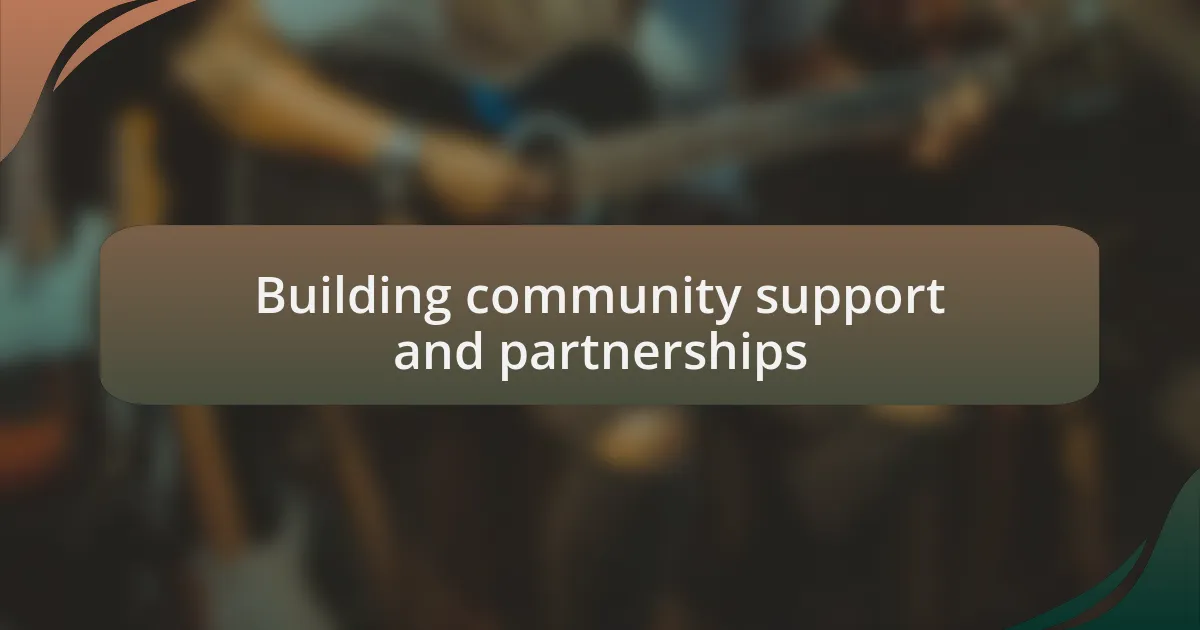
Building community support and partnerships
One impactful approach to building community support is to organize local music events that invite participation from students, families, and local musicians. I recall coordinating a community concert where students showcased their talents alongside established artists. The energy was electric, and witnessing the pride in my students’ faces as they performed was heartwarming. It dawned on me how such events not only enhance the visibility of the music program but also foster a sense of belonging and support within the community.
Forming partnerships with local businesses can also make a significant difference. I approached a nearby music store with the idea of hosting instrument donation drives. Their willingness to support our initiative was unexpected yet incredibly uplifting. Each time I saw students playing instruments that might not have been available otherwise, I felt a deep sense of gratitude. Have you considered which local businesses might share your vision and be willing to help nurture young musicians?
Moreover, creating a mentorship program with high school music students can ignite enthusiasm across various levels. I introduced a buddy system where older students guided beginners in music theory and performance. Witnessing the relationships that grew out of this initiative was inspiring; it not only empowered the mentors but also helped the younger students feel more connected to their musical journey. What mentoring opportunities could you explore to strengthen your musical community?
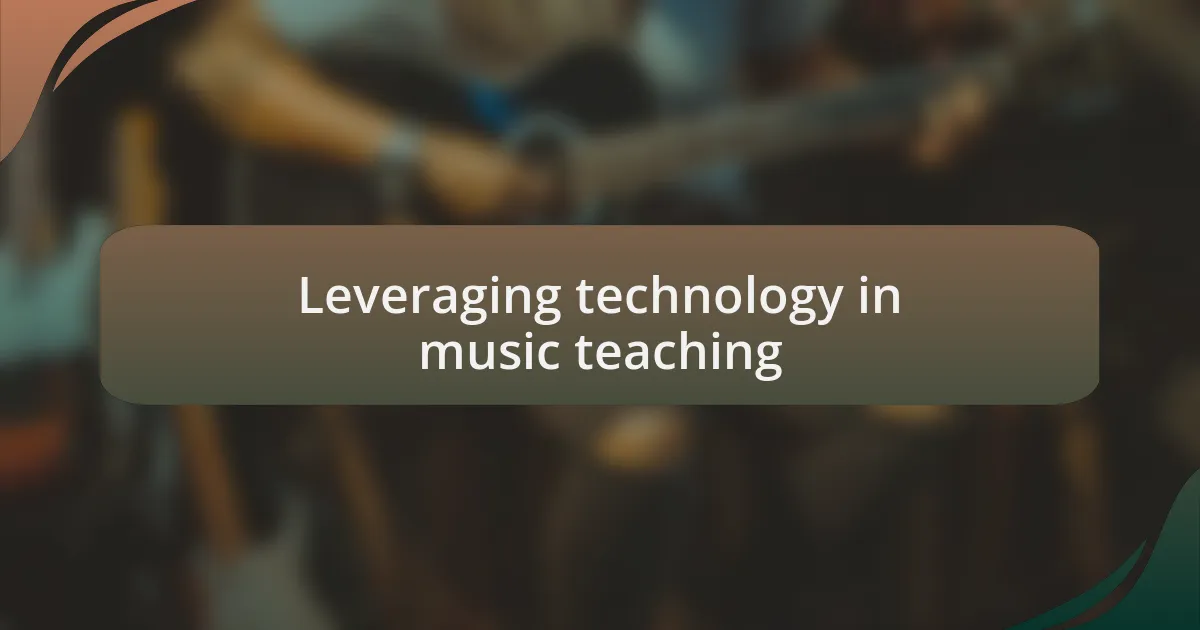
Leveraging technology in music teaching
Utilizing technology in music education has become a transformative tool for both teachers and students. I remember my first experience with an online music collaboration platform; we were able to share compositions in real-time, regardless of where each student was located. This not only enhanced their creativity but also fostered a surprising camaraderie, as students were genuinely excited to receive feedback from peers they may have never met otherwise. Have you ever considered how virtual collaboration could enrich your teaching experience?
In my classroom, digital tools like music composition software and online tutorials have opened a world of possibilities. On one occasion, I introduced my students to an app that allowed them to compose their own music using samples and loops. Watching their eyes light up as they created unique pieces was an unforgettable moment. It made me realize that technology can bridge gaps in learning; it gives students who may struggle with traditional methods an engaging way to express themselves. Have you explored the digital resources that might resonate with your students’ needs and interests?
Furthermore, online learning platforms offer immense opportunities for remote instruction. I once hosted a live-streamed workshop for students during a school closure to keep the momentum going. It was incredible to see the engagement levels rise as students participated from their own homes, offering insights and asking questions in real-time. This experience confirmed my belief that technology not only maintains the continuity of learning but also enhances the excitement surrounding music education. What online tools could you integrate into your lessons for an even more dynamic experience?
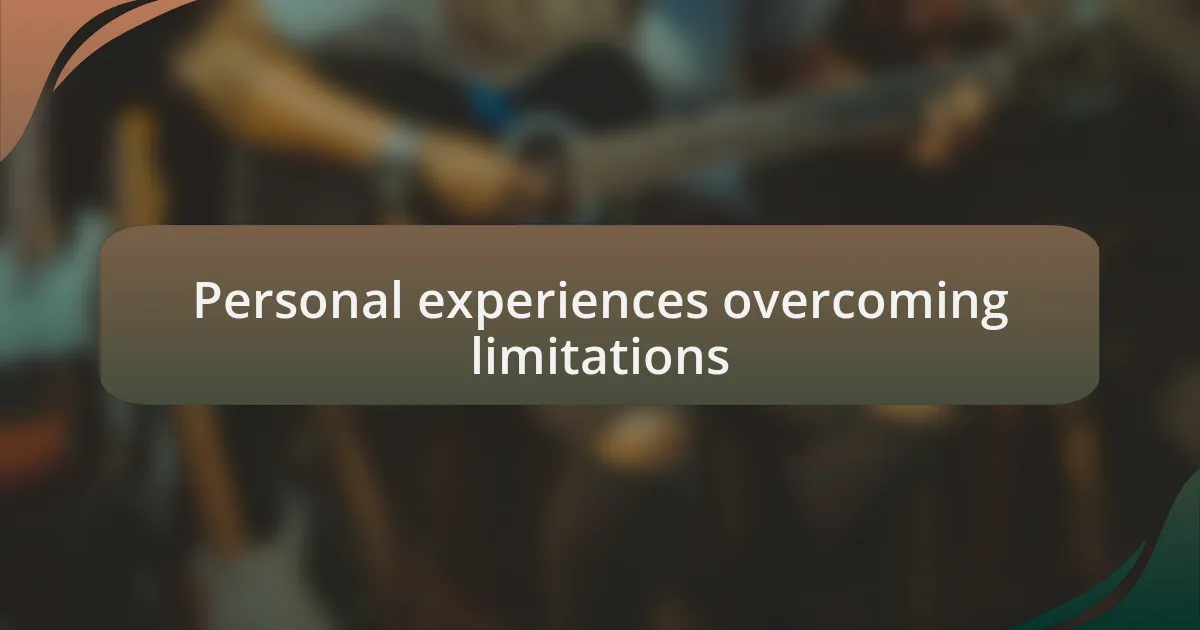
Personal experiences overcoming limitations
I remember when my first music program faced budget cuts, leaving us with dwindling resources for instruments and materials. Rather than feeling defeated, I decided to tap into the community. I reached out to local musicians and small businesses, sharing our needs and passion for music education, and was pleasantly surprised by the overwhelming support we received. It taught me that sometimes, overcoming limitations means putting yourself out there and finding allies who share your vision.
One challenging semester, I had a class filled with students from various backgrounds, some lacking access to instruments at home. To address this, I created a series of classroom stations featuring alternative instruments, like digital keyboards and drumming apps, allowing students to explore music regardless of their prior experience. The joy on their faces when they engaged with the materials was rewarding; it reminded me that creativity thrives even when traditional resources are scarce. Have you ever considered how diverse tools can empower your students to unlock their musical potential?
During a particularly tough academic year, I faced the challenge of keeping students motivated without live performances to showcase their progress. To cope with this, I organized virtual recitals where students could share their musical growth via video recordings. The sense of accomplishment they felt when watching peers celebrate their efforts was palpable, and it solidified my belief that limitations can often lead to innovative solutions. How might you adapt your teaching methods to inspire your students when faced with obstacles?
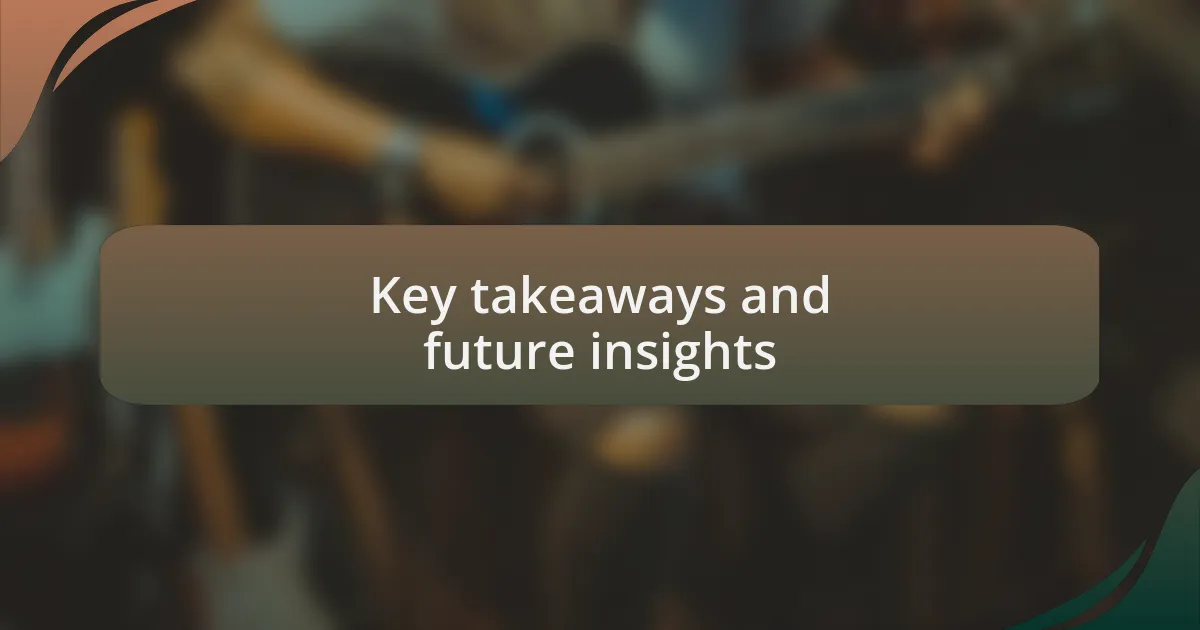
Key takeaways and future insights
Finding innovative solutions in the face of resource limitations can be a transformative experience. For instance, during a summer camp, I received a generous donation of used instruments, but many were in poor condition. Instead of viewing this as a setback, I initiated a “Instrument Repair Day,” where students learned basic maintenance skills while fixing the instruments together. This not only empowered the students but also fostered teamwork and a deeper appreciation for the tools of music. Have you thought about how such collaborative efforts can create both learning opportunities and a sense of community?
One crucial insight I garnered was the importance of adaptability. There was a time when our usual curriculum had to pivot due to a lack of resources for live projects. I introduced a module focused on music production using free software, which allowed students to create their own compositions. Watching their creativity flourish with the digital tools available was eye-opening. How often do we underestimate the potential of technology in music education?
As I look to the future, I envision a world where resource limitations spur even greater creativity within music education. The experiences I’ve had have taught me to harness the power of collaboration and technology, and I believe that nurturing these skills will prepare students for a rapidly evolving musical landscape. What strategies can you implement in your own teaching to inspire adaptability and resilience in your students?